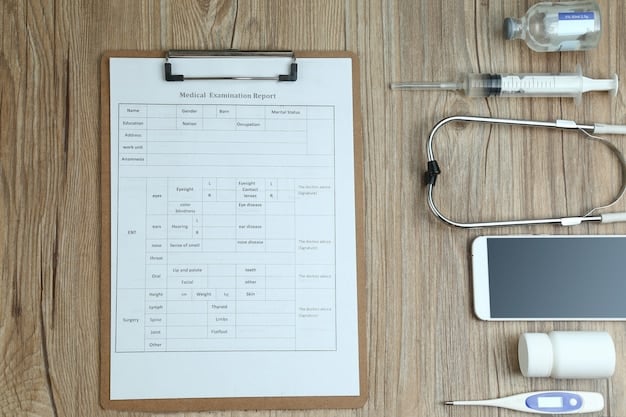Price Transparency in Hospitals: A 2025 Guide to Federal Mandates

Navigating the New Federal Mandates for Price Transparency in Hospitals: A 2025 Guide explains the current regulations requiring hospitals to disclose pricing information, the rationale behind these mandates, how hospitals are complying, and what the future impact may be on patients and the healthcare industry.
The healthcare landscape is constantly evolving, and one of the most significant shifts is the increasing demand for price transparency. Navigating the New Federal Mandates for Price Transparency in Hospitals: A 2025 Guide will help you understand these changes.
Understanding the Push for Price Transparency in Healthcare
Price transparency in healthcare aims to provide patients with clear, accessible information about the cost of medical services before they receive them. This initiative is driven by the belief that informed patients can make better decisions about their care and ultimately drive down healthcare costs.
Before diving into the specifics of the federal mandates, it’s crucial to understand the underlying reasons and the intended benefits of price transparency in the US healthcare system.
The Rationale Behind Price Transparency
The push for price transparency is rooted in several key factors. Firstly, it addresses the information asymmetry that exists between healthcare providers and patients. Secondly, it promotes market competition that could lead to more affordable healthcare.
- Empowering Patients: When patients know the cost of a service beforehand, they can compare prices and choose options that fit their budget.
- Driving Down Costs: Transparency encourages hospitals to be more competitive, potentially leading to lower prices for consumers.
- Reducing Surprise Bills: By knowing costs upfront, patients are less likely to receive unexpected and unaffordable medical bills.
The goals are to eliminate uncertainties and empower patients to take control of their healthcare expenses.
The Current Federal Mandates: A Detailed Overview
As of 2025, hospitals across the United States are operating under federal mandates aimed at increasing price transparency. These mandates require hospitals to disclose pricing information in two primary ways.
These mandates have been structured to address several concerns, from reducing billing surprises to empowering consumers to make responsible health choices.
Machine-Readable File
Hospitals must publish a comprehensive machine-readable file containing all standard charges for all services, including gross charges, payer-specific negotiated charges, and discounted cash prices. This file must be updated annually or more frequently.
Shoppable Services Display
Hospitals are required to display shoppable services in a consumer-friendly format. This involves providing clear and accessible information on the cost of at least 300 common services that patients can shop for, allowing individuals to compare prices easily.

These measures are designed to empower consumers to make informed decisions and reduce the likelihood of unexpected medical expenses.
Hospital Compliance: Challenges and Strategies
While the federal mandates are clear in their intent, hospitals face numerous challenges in achieving full compliance. These challenges range from technical issues related to data collection and formatting to broader issues of cultural and operational adjustment.
Despite the complexities, many healthcare institutions are actively working to meet these requirements and leverage them to improve patient trust and satisfaction.
Overcoming Technical Obstacles
One of the primary challenges is managing and formatting the vast amount of data required for compliance. Hospitals must invest in the technologies and infrastructure to collect, organize, and publish pricing information accurately.
Addressing Operational and Legal Concerns
Hospitals must also navigate legal and operational concerns. Negotiating payer-specific rates, defining ‘shoppable’ services, and ensuring data accuracy are all critical components of compliance.
- Data Accuracy: Ensuring that pricing information is correct and up-to-date.
- Patient Communication: Effectively communicating pricing information to patients in a way that is easy to understand.
- Legal Compliance: Staying abreast of changes in regulations and ensuring that all practices align with federal mandates.
Addressing these concerns requires a collaborative effort among hospital staff.
The Impact of Price Transparency on Patients
The ultimate goal of price transparency is to empower patients and improve their healthcare experience. By providing clear and accessible pricing information, these mandates aim to reduce financial burdens and promote informed decision-making.
However, the impact on patients is multifaceted and understanding these potential impacts is crucial for policymakers and healthcare providers alike.
Empowering Informed Decisions
Price transparency enables patients to compare costs across different healthcare providers, allowing them to choose options that best fit their needs and budget. This can lead to more cost-effective decisions and reduced financial strain.
Reducing Financial Burdens
By understanding the cost of care upfront, patients are less likely to be hit with surprise bills or unexpected expenses. This can alleviate financial stress and improve patient satisfaction.

Price transparency initiatives can enhance trust between patients and providers.
The Future of Price Transparency in US Healthcare
Looking ahead, the push for price transparency is likely to continue, with potential expansions and refinements to the current mandates. Several trends and developments could shape the future of healthcare pricing in the US.
These ongoing efforts are aimed at creating a more transparent, equitable, and patient-centered healthcare system.
Potential Expansions of Mandates
Future mandates could extend beyond hospitals to include other healthcare providers, such as physician practices and outpatient clinics. This would provide patients with a more comprehensive view of healthcare costs across the entire system.
Technological Advancements
Advances in technology, such as AI and machine learning, could streamline the process of collecting, analyzing, and presenting pricing information. This could make it easier for hospitals to comply with mandates and for patients to access and understand pricing data.
- Artificial Intelligence: Using AI to analyze pricing data and provide personalized cost estimates.
- Mobile Apps: Developing mobile apps that allow patients to compare prices and access pricing information on the go.
- Telehealth Integration: Integrating pricing information into telehealth platforms to provide patients with cost-effective virtual care options.
The healthcare industry may see an increased integration of price comparison tools and platforms.
Preparing for 2025 and Beyond
As we move closer to 2025 and beyond, healthcare stakeholders must take proactive steps to prepare for the ongoing evolution of price transparency mandates. This includes hospitals, patients, policymakers, and technology providers.
By staying informed, adopting best practices, and investing in necessary resources, stakeholders can navigate the changing landscape and contribute to a more transparent and equitable healthcare system.
For Hospitals
Hospitals should continue to invest in technology and infrastructure to comply with price transparency mandates. This includes implementing systems for data collection, analysis, and reporting, as well as training staff to communicate pricing information effectively to patients.
For Patients
Patients should take advantage of the resources available to them, such as hospital price transparency tools and online databases. By comparing prices and understanding their coverage options, patients can make informed decisions about their care and reduce their financial burdens.
| Key Element | Brief Description |
|---|---|
| 🏥 Federal Mandates | Hospitals must disclose pricing via machine-readable files and shoppable services displays. |
| 💰 Patient Impact | Patients make informed decisions, reduce surprise bills, and enhance trust with providers. |
| 🚀 Future Trends | Mandates may expand to other providers; technology such as AI will streamline pricing data. |
| ⚖️ Compliance | Hospitals face technical and operational challenges, requiring investment in data management and compliance. |
Frequently Asked Questions (FAQ)
▼
The key requirements include publishing a machine-readable file of all standard charges and displaying shoppable services in a consumer-friendly format. This helps patients understand and compare costs for various medical services.
▼
These mandates empower patients to make informed decisions about their healthcare by providing clear pricing information upfront, reducing the likelihood of surprise medical bills and enabling cost comparisons.
▼
Hospitals face technical challenges in managing and formatting large amounts of pricing data. They also encounter operational and legal concerns in ensuring data accuracy and effectively communicating with patients.
▼
Future trends include the potential expansion of mandates to other healthcare providers, technological advancements like AI to streamline pricing data, and increased integration of price comparison tools in healthcare platforms.
▼
Patients can prepare by taking advantage of hospital price transparency tools and online databases to compare prices. Understanding coverage options and staying informed will help make cost-effective healthcare choices.
Conclusion
Navigating the new federal mandates for price transparency in hospitals is vital for all healthcare stakeholders. By understanding the current regulations, challenges, and future trends, hospitals, patients, and policymakers can work together to create a more transparent, equitable, and patient-centered healthcare system.





